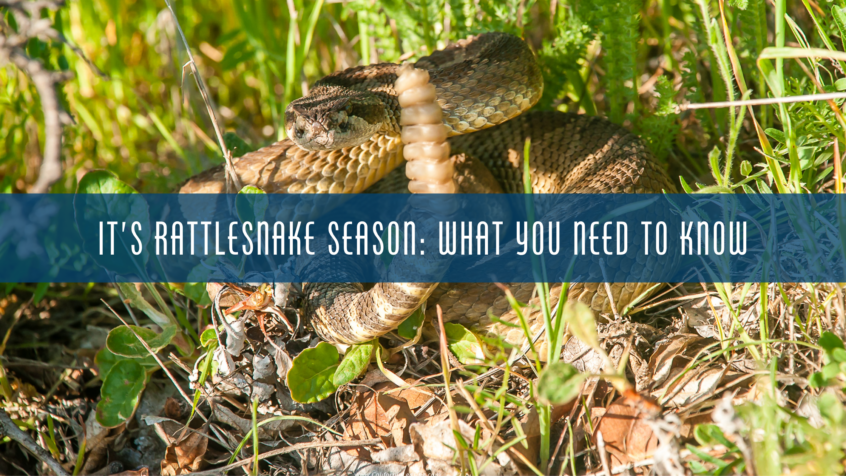Spring brings a lot of wonderful things, but it also brings rattlesnake season. During this time, Southern Pacific rattlesnakes, the most common species in the L.A. area, come out of hibernation to mate. If you’re planning to spend time in the wilderness, here are ten things you need to know about rattlesnakes.
- When is Rattlesnake Season? The rattlesnake season doesn’t have a specific end date. It starts in spring and lasts until L.A.’s really big heat when the snakes become nocturnal, and you’re less likely to encounter them in the wilderness.
- What do Rattlesnakes in So Cal look like? Rattlesnakes commonly found in the L.A. region are Southern Pacific snakes. These snakes have thick bodies, triangular heads, and short, stubby tails that feature a clear, hollow rattle at the end. They can grow up to 4 feet long and come in various shades of pale or dark brown, gray, and everything in between. Additionally, they have a distinctive diamond pattern of lighter dots on their bodies.
- What should I do if I encounter a Rattlesnake while hiking? Nothing, except maybe take a picture–from a distance. Local rattlers are pretty docile and don’t like conflict. Don’t pick them up or poke them with a stick. If you’re on a trail, give the snake a wide berth and walk by. If you can’t pass comfortably at a distance, retrace your steps. Hikers should take precautionary measures to wear long pants and boots that protect their ankles. Also, never hike alone in case you get bitten and need a second person to get help.
- What does it mean if I hear a rattling noise? It means you need to be very careful. Rattlers are one of the few species that sometimes give you a clear warning they may be ready to strike. Scan the area and try to locate the snake, then take heed and back away. But know this: Not all rattlesnakes rattle before they strike.
- What should I do if I get bitten by a Rattlesnake? You need to call 911 or go to an emergency room immediately. (It’s a good idea to know where the nearest emergency room is before you go hiking.) Also, if possible, wash the wound with soap and water, and elevate the afflicted arm or leg above the level of the heart. At the hospital, you may be monitored and, if necessary, treated with antivenom, depending on the bite (some may suffer “dry” bites, in which no venom is injected into the person’s leg or arm).
- If I do get bitten by a Rattlesnake, is it ok to run or hike out of my location? Do whatever it takes to get help as soon as possible.” The idea that moving around pumps venom through your body more quickly isn’t accurate. Venom circulates not by blood but through your lymphatic system, which moves fluids more slowly through the body. What you absolutely shouldn’t do is anything you saw in those old western movies, such as putting a tourniquet on the affected limb, cutting an “X” over the bite and sucking out the venom, or packing it with ice.
- Are Rattlesnake bites lethal? While possible, it is highly uncommon for someone to die from a rattlesnake bite. However, allergic reactions to venom or a bite directly into an artery or vein can result in significant blood loss.
- What should I do if I find a Rattlesnake in my backyard? It is not recommended to personally handle or kill a rattlesnake in your backyard, especially if you are not trained to do so. Instead, you should contact L.A. County’s Department of Animal Care and Control at animalcare.lacounty.gov to safely remove the snake. It’s important to remember that even if the snake is dead or dying, it can still transmit venom if you accidentally come into contact with its fangs.
- What should I do if my dog gets bitten by a Rattlesnake? Compared to humans, dogs have a slightly higher resistance to snakebites. While dogs can survive a snakebite without treatment, the bite can still be painful, so it’s important to take your pet to a veterinarian for a checkup. To prevent snakebites, it’s recommended to keep your dog on a leash when walking or hiking in areas where rattlesnakes may be present.
- Are baby Rattlesnakes more lethal than adult snakes? Contrary to popular belief, it’s not entirely true. Although it’s been said that young rattlesnakes are unable to regulate their venom (though this claim is contested by some experts), larger snakes have larger venom sacs and can deliver much more venom than their younger counterparts, according to Greg Pauly, a herpetologist at the Natural History Museum in Los Angeles, as reported by Bay Nature.

